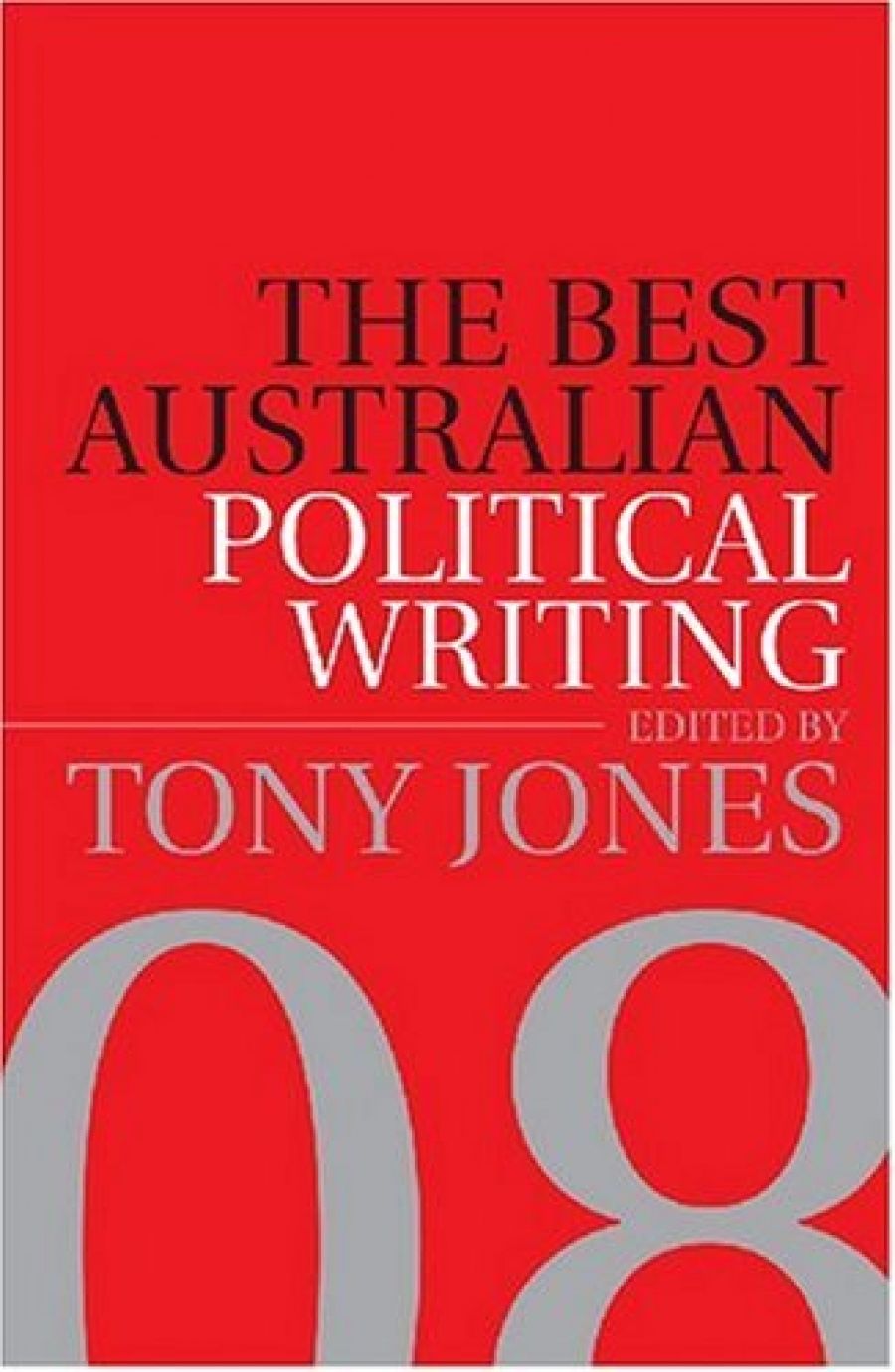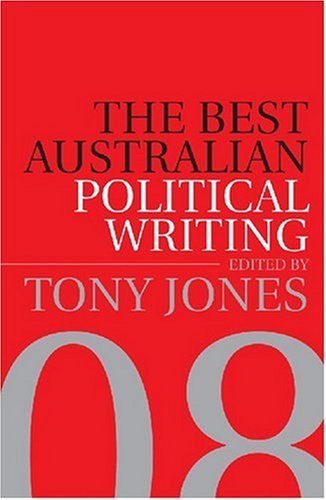
- Free Article: No
- Custom Article Title: Winner takes all
- Review Article: Yes
- Article Title: Winner takes all
- Online Only: No
- Custom Highlight Text:
In The Best Australian Political Writing 2008, the ABC’s Tony Jones, a latish replacement as editor for the Canberra-bound Maxine McKew, has assembled forty-two pieces of non-fiction first published in 2007. The result is a mixed bag of genres, including columns, investigative journalism, polemic, book extracts and essays (but, alas, no fiction). The subject matter includes the November federal election, indigenous affairs, the environment, the ‘war on terror’, Australian values, and the artlessly named ‘culture wars’. The package sounds enticing, but while there’s plenty of insightful and relevant commentary – and some sublime prose – there’s also sometimes an ephemeral limpness, and an earnestness, to the anthology.
- Book 1 Title: The Best Australian Political Writing 2008
- Book 1 Biblio: MUP, $32.95 pb, 394 pp
- Book 1 Cover Small (400 x 600):

- Book 1 Cover (800 x 1200):

Given that 2007 was an election year, Jones opens and closes the anthology with mini-collections on federal politics. There is excellence here, including Simon Mann’s portrait of a younger (and steely) Kevin Rudd, and George Megalogenis’s assertion that ‘The notion that federal governments manage the economy in the same way that a chief executive would run a business is, frankly, delusional’. But some of the writing seems past its prime and of rapidly diminishing interest. It is a problem that afflicts even the best of the election-focused commentaries: Judith Brett’s forensic and contextual assessment of John Howard’s drifting fortunes. First published in March 2007, Brett’s essay remains incisive, but it has been entirely superseded by the Quarterly Essay she published after Howard’s demise (Exit Right: The Unravelling of John Howard, Black Inc., no. 28, 2007).
That Brett’s standout essay has lost its relevance (though not its spark) is symptomatic of an editorial conundrum confronting Jones: what should constitute ‘best’ in the phrase ‘best political writing’? Is it the most prescient? The most persuasive? The most detailed and accurate? The most contextual? The most lyrical or dynamic or idiosyncratic? In his introduction, Jones poses the questions ‘who really got it? Who best read the tea leaves? Who understood what was actually going on in the minds of the electorate?’ But there is no neat formula that he can employ to circumvent the fact that, say, investigative journalism has different qualities from essay writing, or that some types of writing – especially journalism, opinion pieces and polemic – can be both vitally important and designed for instant consumption.
Whatever his definition of ‘best’ is, the selections seem influenced by a broader range of editorial concerns. Jones attempts to combine the various contributions into a cohesive narrative, forming a sort of summary of 2007. While that’s an entirely legitimate approach, one effect is to exclude writing that does not conform to Jones’s chosen themes. Another consequence is that Jones seems to have included some commentators – Hugh Mackay, Phillip Adams and Michelle Grattan, among others – more because they should be represented than because there is anything especially noteworthy about the particular writing included here.
More troublesome is Jones’s preoccupation with balance. For instance, Paul Keating’s post-election gloat at Howard’s defeat (as writing, it works best if you close your eyes and imagine Keating ranting in some doorway) stands alongside historian Geoffrey Blainey’s assertion that ‘in the end, John Howard will be seen by vast numbers of Australians as one of the great prime ministers’. While Keating’s column is a reasonably entertaining (although not very sporting) catharsis, Blainey’s sloganeering does little justice to either his considerable insights into Australia or his ability to craft magnificently elegant sentences. But having Blainey follow Keating is a tick for fairness, a blow to any perception of bias.
Similarly, after geologist Bob Carter lauds Martin Durkin’s television documentary, The Great Global Warming Swindle, Clive Hamilton tersely counters that ‘there is a sharp distinction between healthy scepticism and cynical manipulation of the facts’. In his introduction, Jones (who moderated a live debate after the documentary screened on the ABC) states that he included Carter’s piece ‘to indicate the temperature of the debate that was seen by some as a last gasp of climate change denial’, but that seems an odd sort of rationale.
Despite the unevenness of The Best Australian Political Writing 2008, and the uncertainty of its purpose, it contains plenty of vigorous, evocative and thought-provoking writing. The best examples are not merely well written or researched (although they are that, too), but offer a stimulating fresh insight into some political controversy or issue. Novelist Chloe Hooper, for instance, writes with poetic sensitivity about the multiplying effects of the drought and the water worries of farmers in rural Victoria. And journalist Tony Koch provides a searing account of the life of the twelve-year-old girl who was gang-raped in the indigenous settlement of Aurukun. Hooper and Koch both abandon headlines and dig deeply into the context and the complexities of the issues. They use a strong narrative to tell human stories, allowing the storytelling to enhance, not obscure, broader political issues.
In his essay interpreting the 2005 suburban riots in Macquarie Fields in Sydney, academic David Burchell writes: ‘Military historians have pointed out that, in many cultures, if you want to have a satisfactory battle it’s necessary for both sides to agree tacitly on where and how to hold it. Likewise, many of our most bitter political controversies involve a strange kind of conceptual complicity among the warring parties.’ The most persuasive and exuberant selections in the anthology are those that disregard existing formulaic debates. Burchell, for instance, puts Australia’s ‘welfare islands’ in historical context, and in so doing refuses to be hemmed by the sort of choreographed left/right debate (‘myopic’, he calls both sides) that reduces an intricate and sensitive issue to a long tennis rally.
Similarly, in his tightly argued critique of left politics, Guy Rundle reflects on what he calls the ‘rupture’ of the alliance between the labour movement and ‘left-liberal cultural professionals’. He asserts that the breaking of this alliance, coupled with a sort of averting of the collective left-liberal gaze, reshaped the political and cultural landscape ‘more than any government policy or conscious mendacity by elements of the press’. Of course, Rundle’s position is not the definitive word, but he acknowledges that ‘the times are moving far more radically than conventional political movements can allow for’, and he is willing to confront the resulting messiness.
In contrast, Tom Switzer’s essay attempting to explain why conservatives are no longer losing the ‘culture wars’ is rooted in a dichotomy of ‘us and them’. ‘No longer are Australians told to be ashamed of their country’, Switzer says, resorting to the standard oversimplified ‘three cheers’ versus ‘black armband’ argument that has distracted too many combatants in this phoney ‘war’. Switzer argues that ‘far from being silenced, left-wing voices have simply lost their relevance’, whereas Rundle makes a genuine effort to understand why the left has struggled to assert itself, and what that might mean for society. It doesn’t make Rundle right, but it does make his essay vastly more germane.
Perhaps the centrepiece of The Best Australian Political Writing 2008 is Cape York indigenous leader Noel Pearson’s dense but highly readable essay, ‘White Guilt, Victimhood and the Quest for a Radical Centre’. In a bravura performance, Pearson argues for a combined agenda of responsibilities as well as rights for indigenous Australians, including a shift away from welfare-based responses to indigenous disadvantage: ‘Who in world history has ever been saved by anyone in the way we hope whitefellas will save our people?’ Pearson’s arguments about race, here and in the United States, are finely calibrated and steeped in learning. A superbly candid and precise writer, his language is powerful but subtle. But there is nothing easy about the practical application of Pearson’s ideas, and Rundle points out that Pearson’s public comments about the Howard government’s approach to indigenous affairs, including the Northern Territory intervention, shifted often enough that he was left ‘looking like, well, a bit of a mug’. But in laying out his argument with such care, and in refusing to advocate some convenient artificial consensus, Pearson exposes his views to full scrutiny (as does Rundle’s essay on the left), an act of courage for any public intellectual.
On the evidence of this anthology, political writing in Australia shows signs of glowing health, but it is still a little grumpy and set in its ways. The opinion-maker’s role in Australian society is a vexing one. On the one hand, we want – we need – our experts to publicly engage in current affairs debates much more frequently than is currently the case. But on the other hand, to speak out is to run the risk of resorting to oversimplification or misrepresentation. Tom Keneally, in a meandering essay about race, briefly considers the stark difference between Geoffrey Blainey the eminent historian and good bloke, and Geoffrey Blainey the sometimes provocative social commentator. Keneally soon drifts back to his main point: that fear of outsiders is unwarranted, but it is a pity he didn’t think more about his two Geoffrey Blaineys. The difficult task facing public intellectuals such as Blainey reveals a great deal about the rigidity, and the winner-takes-all competitiveness, that partially – only partially – infects Australia’s media-dominated national conversation.


Comments powered by CComment